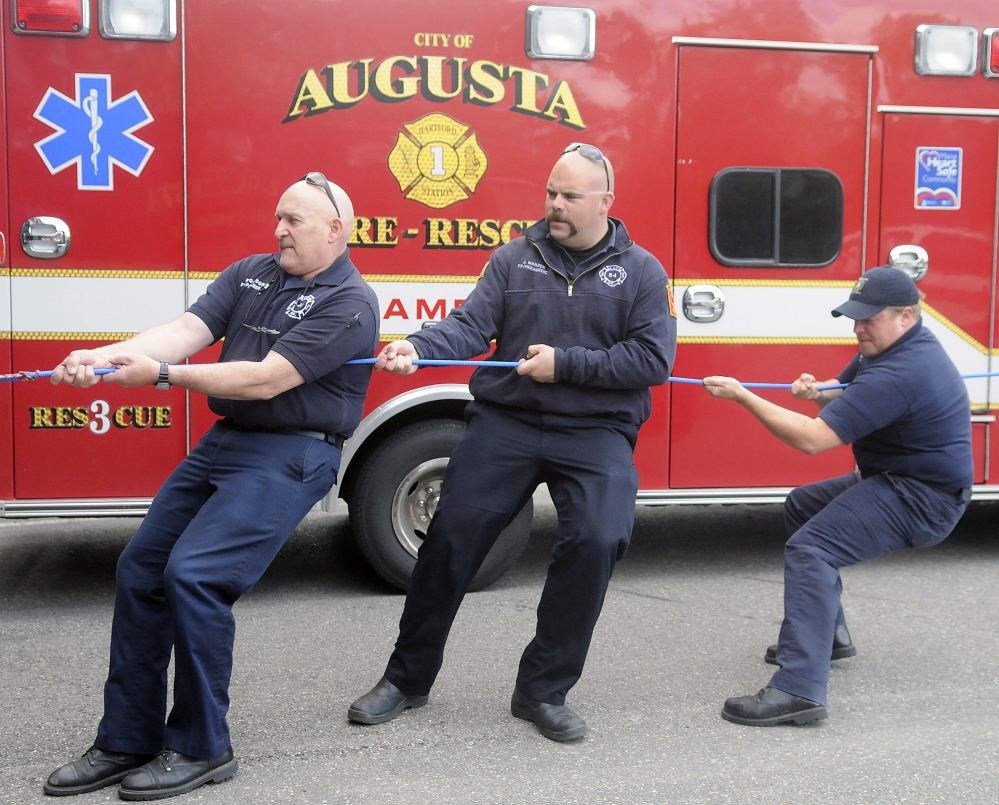The sight of an Augusta ambulance at an accident scene or outside a home where someone has fallen ill is commonplace these days.
But it wasn’t that long ago when there was no emergency medical service in the city. That changed in 1975, when Augusta became one of the first cities in the state to establish its own emergency medical service as part of the fire department. The department highlighted its 40th year during last week’s national EMS week.
“In the old days, it was pretty much pick them up, control the bleeding, give them oxygen and get them to the hospital,” said Augusta Fire Chief Roger Audette. “Most of the transporting of people to the hospital was done by the funeral homes. That was kind of standard in the area.”
Since those early days, municipal EMS has become standard across the country. Lewiston is the only metropolitan area in Maine that does not provide a city-run EMS, Audette said. He said Augusta’s service, like those around the state, has saved countless lives.
“The ambulances and paramedics can pretty much do everything that an emergency room physician can do if you walked in the door with the same illness,” Audette said.
Emergency medical service grew, in part, out of the information gained treating wounded soldiers during the Vietnam War, Audette said. First responders began to realize that the care used to treat the wounded could help save the lives of people here who suffered traumatic injury.
LOS ANGELES LED THE WAY
Los Angeles, the first city in the nation to offer EMS, began in the late 1960s to study how to reduce deaths from cardiac arrest.
The research led to the Soviet Union, which had used a dispatched ambulance service with a physician and a nurse for the better part of a decade, according to the National EMS museum. Los Angeles in 1969 selected firefighters, nurses and rescue members to begin a mobile paramedic program.
Motivated by the success of that program, cities across the country began to follow suit. Augusta’s turn came in 1975.
Charlie Squires, who began his 33-year career with the Augusta Fire Department in 1976, said his hiring represented a shift in philosophy for the fire department.
“I was one of the first ones hired because I was an emergency medical technician,” said Squires, who retired as a battalion chief in 2009. “Before that, they were hiring firefighters and training them to an EMT level.”
Squires and the other EMTs were given about 100 hours of training in basic first aid, but Augusta’s EMS these days is populated almost exclusively by paramedics who have undergone at least two years of training and are qualified to perform an array of life-saving treatments from giving medications to airway support.
“They’re obviously a little more advanced on the type of equipment they use, and their ability to use the equipment has really advanced,” Squires said. “Their knowledge is what has really advanced since back then.”
PUBLIC MORE AWARE
Bill Cusick, who retired from the Augusta Fire Department in 2009 after serving for 25 years, was one of the first people in the state to finish a 16-month paramedic program at Northeastern University in Boston. In those days, Cusick said, the only treatment for cardiac arrest was cardiopulmonary resuscitation.
While the EMS was an immediate improvement in the care of patients, Augusta’s service responded to fewer than 700 calls in 1975.
“Last year we did about 4,500 EMS calls,” Audette said. “The amount of work that we do is the absolute biggest change.”
Squires said people are much more likely now to call for an ambulance than they were in the early days. “The general mindset was you don’t go the hospital unless you’re really, really hurt or really, really sick,” Squires said.
That public mindset began to change for a number of reasons, including the popular television show “Emergency!” that ran from 1972 to 1979.
“They kind of put medical care in the streets in front of everybody,” Squires said. “People saw that and said, ‘How come I can’t have that?'”
‘A TOTAL HEALTH SYSTEM’
Emergency medical services these days is about a lot more than just ambulances and paramedics, Audette said. It begins with a universal 911 system, making it easy to call for help, and dispatchers who are trained to not only send the right people to help, but can offer support to callers until that help arrives.
The service includes contact between ambulance crews and hospital emergency room staff to provide better and faster care.
Perhaps just as importantly, EMS includes public education and the promotion of installing life-saving devices like automated external defibrillators in public places.
“It’s a total system,” Audette said. “In the last couple of months, there were incidents of people having a cardiac arrest and bystanders doing CPR. They’ve been wins and those people have walked out of the hospital and are alive today. It’s a total health system.”
When Squires first started, EMS mostly meant bandages and splints. Now its electronic heart monitors, IVs and breathing equipment.
“Your survival rate is a lot better than back then,” Squires said. “What happens in the first few minutes can make a big difference in how long you spend in the hospital, if you even make it there. The knowledge they have now allows your stay in the hospital to be significantly reduced.”
Send questions/comments to the editors.




